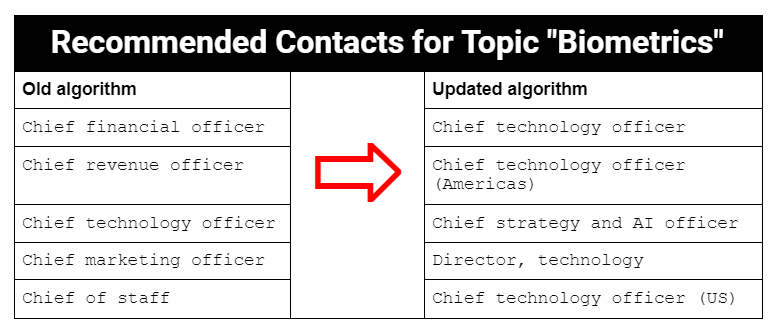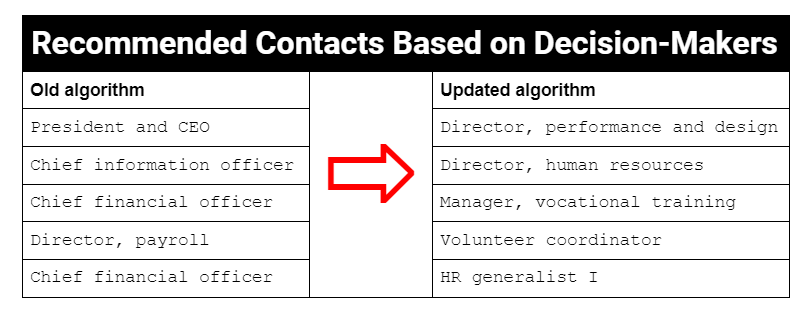At ZoomInfo, we’ve put a lot of time and effort into providing top-notch buyer intent data.
Our Intent product monitors web traffic to understand which companies are consuming content about specific topics more than usual. If a company that normally doesn’t research “applicant tracking systems” starts showing heavy consumption of that topic that exceeds historical baselines, there might be a strong buying opportunity.
With ZoomInfo Intent, we provide customers with a handful of contacts to target based on who the typical buyer is for that customer’s service or product. If a company is showing increased consumption for applicant tracking systems, we’re going to suggest to sellers that sell in this space to reach out to professionals in talent acquisition or recruiting.
Likewise, if a company is spiking on the topic “marketing automation system,” we’re going to suggest that sellers reach out to individuals in marketing operations at that company.
In October 2020, ZoomInfo acquired Clickagy, a leading provider of artificial intelligence-powered buyer intent data. A month later, we released a brand new Streaming Intent product, which delivers intent signals directly to customers as they happen in real time. We released a new user interface, new delivery mechanisms, and new topics. In December, we endeavored to break down our recommended contacts algorithm and rebuild it for greater accuracy.
More Contacts Based on Intent Signals
We’re not simply recommending better contacts — we’re also recommending more contacts. We took a random sample of 100 companies and tested them before and after we enhanced the product. Here’s what we found:
We’re recommending 31% more contacts on intent signals
The number of companies with recommended contacts for intent signals went from 84% to over 98%
With the increased coverage of recommended contacts, ZoomInfo customers are now able to reach more people at more accounts in areas for which that company is exhibiting above-average consumption of key topics.
If you think about intent-driven outreach campaigns as a funnel, you’ll quickly realize that more quantity and quality at the top of the funnel is a recipe for improved success when using Intent.
How Our Contact Algorithm Respects Your Privacy
There are several reasons we don’t identify the actual person consuming the content:
Key Improvements to Our Algorithm
Let’s take a look at three core improvements to how we recommend contacts in Intent:
1. Better topic-to-job function mappings
We noticed that, previously, too often we were suggesting contacts who weren’t the best people to contact. They weren’t bad, but we knew we could do better.
So we enlisted the help of our corporate research analysts who specialize in our Scoops feature and Intent to review every single topic and which job function we return. This process allowed us to improve the contacts we recommend without even changing our algorithm.
For example, we previously didn’t have the topic ”biometrics” mapped to a popular job function. However, after the change, we’re now getting the correct people:

2. Boosted scoring in metro regions
With Clickagy’s data, we now have a monstrous database of traffic to fuel our signal calculator. These signals are always generated from an IP address, and that address always has a location.
We are now taking the signals of the locations and boosting the recommended contact scoring on all contacts that live in the metro areas where we saw the activity. If a signal comes 100% from Dallas, then contacts in that city will rise to the top of our recommended contacts. If a signal has consumption coming from Dallas and Houston, then individuals at both of those locations will be given more weight.
In our algorithm, the weight of the location match is directly proportional to the amount of consumption we see from there. Here’s an example of a signal based on research in Boston and what we are seeing now and previously:

As you can see, we previously only suggested one contact in Massachusetts, but now we are providing five contacts in the Boston metro area.
3. Preference to decision makers and generalists
At a mid-sized company, the contacts who have budget for, and ultimately purchase, an applicant tracking system are in talent acquisition or recruiting. But what if a company only has two or three people in that space? Or even worse, what if a company has no one in recruiting? This is where we spent the most time improving our algorithm.
You might think that the next best contact to suggest if there are only three contacts in the right job function would be a high-ranking person in human resources. But that line of thinking is wrong. Vice presidents of benefits and compensation are almost certainly not involved in procuring recruiting solutions. Similarly, a payroll director isn’t, either.
Instead, our research showed us that the person our customers wanted to reach most often was someone with general departmental responsibilities, such as a director of human resources. These individuals were more likely to be plugged into the entire workings of the HR department, including recruiting.
So we modified our algorithm to boost the scoring of the individuals who have wide-ranging responsibilities within the HR department. This automatically boosted titles like chief human resources officer, VP of HR, and human resources generalist. These individuals are more likely to know what’s happening in recruiting than someone in payroll.
Here are the before-and-after results for a company looking at the topic “executive compensation”:

The new results point sales reps to potential buyers who are more familiar with executive compensation.
Better Intent Data Fuels Sales Teams
By examining past assumptions in our algorithm for recommended contacts — and then making data-based improvements based on job function, location, and decision makers — we’ve made ZoomInfo Intent a more effective product.
Giving sales reps more top-notch contacts to pursue when a company spikes in online topic consumption increases the likelihood of meaningful sales conversations and, ultimately, closed deals for a product or service.
I’m proud of the work our teams did to enhance ZoomInfo Intent, as it will save our customers time and effort in a competitive environment.


